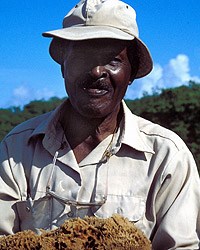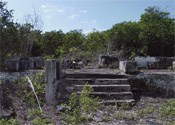|
Meanwhile, Lancelot and Arthur carried on the key lime business. Using their 32-foot boat named the Lone Star, they would carry 250 bushels of limes into Miami every week. They paid John Graham twenty-five percent of their earnings to come up with a quote, then to pack and ship them. They were arguably the largest individual key lime producers in the state. But in 1938, Lancelot and Arthur left the lime business because they felt they couldn’t compete with key lime production in Mexico, which had a considerably better environment for growing limes. In addition, the 1926 hurricane had curtailed lime production. Known as the Great Hurricane, an estimated 392 people died and more than 17, 000 families were affected. Damage to businesses and homes were estimated to be around five million dollars. While the Jones boys managed to continue lime production, the effects of the hurricane initiated the changes that would eventually influence their decision to leave the lime business. Three years earlier in 1935, the Jones brothers had started doing guiding. But during WWII, it became difficult to get fuel, so they stopped guiding for two or three years. They eventually went into bone fishing and resumed guiding. Lancelot fished with many notable men during the forties and fifties, including Herbert Hoover, Lyndon Johnson, Bebe Rebozo and Richard Nixon. These men would visit the Coco Lobo Club, a private club built in 1921 which eventually became the Coco Lobo Fishing club. Supported by wealthy families which included the Firestones and the Honeywells, Lancelot and Arthur provided stone crabs and lobster for the club’s guests. In addition, Lancelot’s expertise was well known and he was often hired as their guide. During the forties, Arthur served as a technical sergeant in the army in World War II and had previously served in the Navy in World War I. Arthur died Feb. 22, 1966, in a VA hospital. He left a wife, Kathleen and a stepdaughter named Leah Forbes. Starting in 1961 and continuing throughout the sixties, a harsh political battle ensued between investors who incorporated the city of Islandia and hoped to develop the islands. Islandia was Miami-Dade County’s smallest municipality, comprised of a chain of thirty-two islands that included the Jone’s property. Lancelot and Arthur were the second largest property owners within Islandia. In addition, they were the only permanent yearlong residents from north Key Largo to Soldier Key. By 1985, only one other private citizen aside from Lancelot Jones lived within the boundaries of Islandia along with park rangers. In 1968 the area was declared a National Monument and in 1980 it was declared a National Park. Motivated by the belief that the area should be preserved prompted Lancelot and his sister-in-law Kathleen to sell their share of the island to the National Park Service in 1970. Made up of more than 277 acres, the National Park Service paid them 1.2 million dollars. Lancelot Jones was granted the right to live out his remaining years in the family home. 

Brenda Lanzendorf Today, the Jones homesite on Porgy Key is accessible only via shallow-draft vessel. In 2013, the site was added to the National Register of Historic Places, and the park is identifying ways to stabilize the house's foundation and develop opportunities for visitors to experience the site without causing additional damage to the site. A bronze plaque, placed on the ruins of the structure by friends after Lancelot’s death, briefly outlines the fascinating story of this pioneering family. |
Last updated: June 18, 2020
